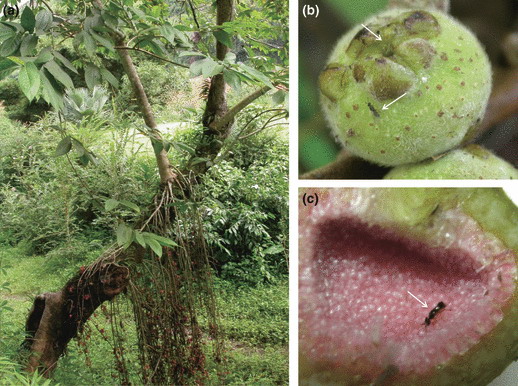In cooperation with French colleagues, Dr. Chen Chun and her supervisor Prof. Song Qishi have analyzed the emissions of volatile compounds by figs of Ficus semicordata and tested its pollinator’s behaviors, which results provide evidence that olfactory cues play a central role in allowing pollinating wasps to locate their specific host plant at the appropriate stage of fig development.
The study suggested that 4-methylanisole is the main signal compound in the floral scent of Ficus semicordata that attracts its obligate pollinator to the host figs at the precise stage required for pollination and oviposition. 4-methylanisole may thus function as a private channel (species-specificity) in this specialized obligate mutualism.

The research result entitled “Private channel: a single unusual compound assures
specific pollinator attraction in Ficus semicordata” has been published online in Functional Ecology.
doi: 10.1111/j.1365-2435.2009.01622.x
Abstract
1. Floral scents have been suggested to play a key role in the obligate pollination mutualism between figs and fig wasps. However, few studies have determined whether pollinator-attractive compounds could alone assure species-specificity (‘private channel’), or whether specificity is mediated by more complex ‘floral filters’, of which scent is only one component.
2. We examined changes in the floral volatile compounds of Ficus semicordata, a dioecious fig species, during and after pollination using headspace collection and compound identification by Gas Chromatography ⁄Mass Spectrometry (GC⁄MS). One benzenoid compound, 4-methylani-sole, was strongly predominant (94–98%) among the volatile compounds emitted by both male and female receptive figs of F. semicordata, whereas it was totally absent in the volatiles emitted by figs 4 days after pollination, as well as in receptive-stage volatiles emitted by two other sym-patric fig species, Ficus racemosa and Ficus hispida.
3. Bioassays using the specific pollinator of F. semicordata, Ceratosolen gravelyi, in a Y-tube olfactometer showed that 4-methylanisole was attractive to C. gravelyi in a wide range of concentrations (from 1Æ22 · 10)2ng ⁄ 100 lLto1Æ22 · 106ng ⁄ 100lL). Moreover, chemical blends lacking 4-methylanisole were unattractive to C. gravelyi. These non-active odour sources included volatile compounds emitted by receptive figs of the two other sympatric fig species and volatiles of F. semicordata post-pollination figs.
4. All these results suggest that 4-methylanisole is the main signal compound in the floral scent of F. semicordata that attracts its obligate pollinator to the host figs at the precise stage required for pollination and oviposition. Furthermore, the high proportion of 4-methylanisole in the odours of receptive figs of both sexes was consistent with the hypothesis of chemical mimicry in dioecious figs.
5. A simple signal comprised of one compound that is unusual among Ficus and that is an infrequent, usually minor, component of other floral odours, may thus function as a private channel in this specialized obligate mutualism.
Key-words: 4-methylanisole, behavioural tests, Ceratosolen gravelyi, chemical mediation, dioecy, nursery pollination mutualism, olfactory signal, post-pollination changes

